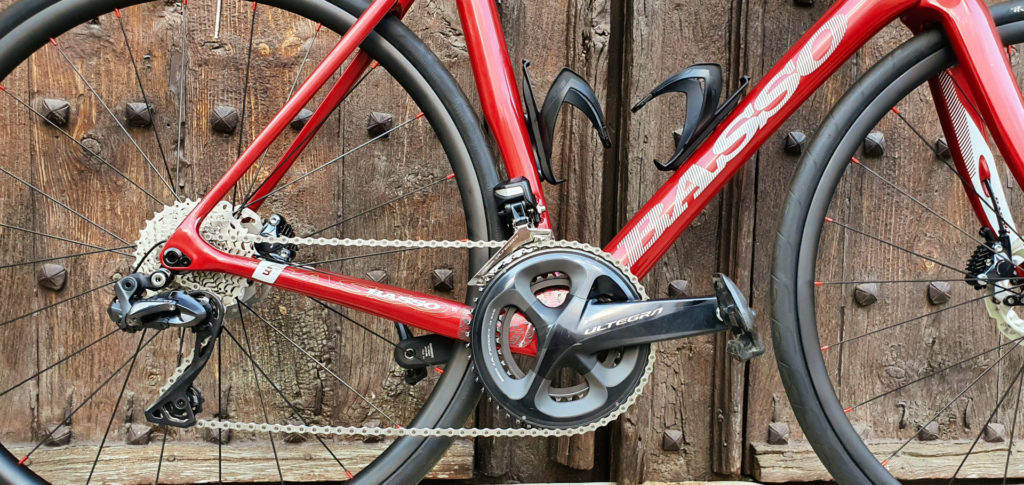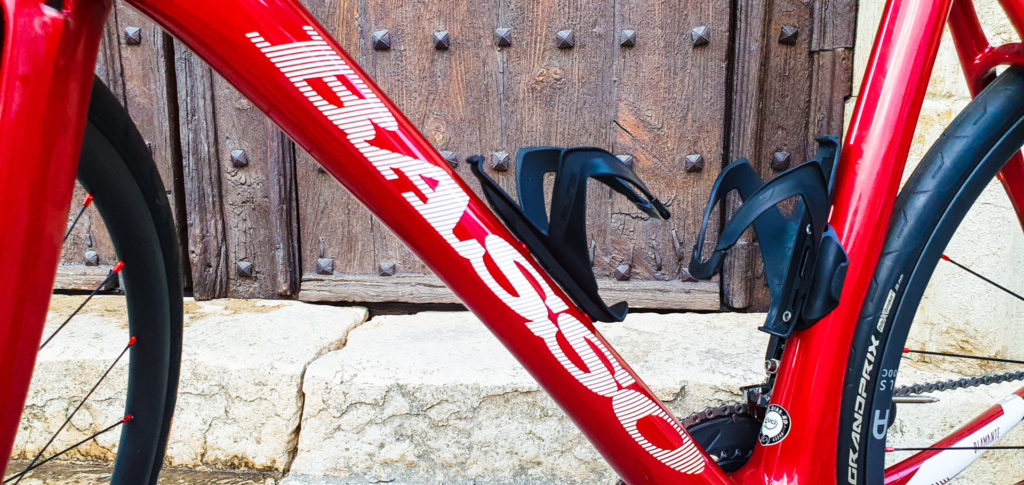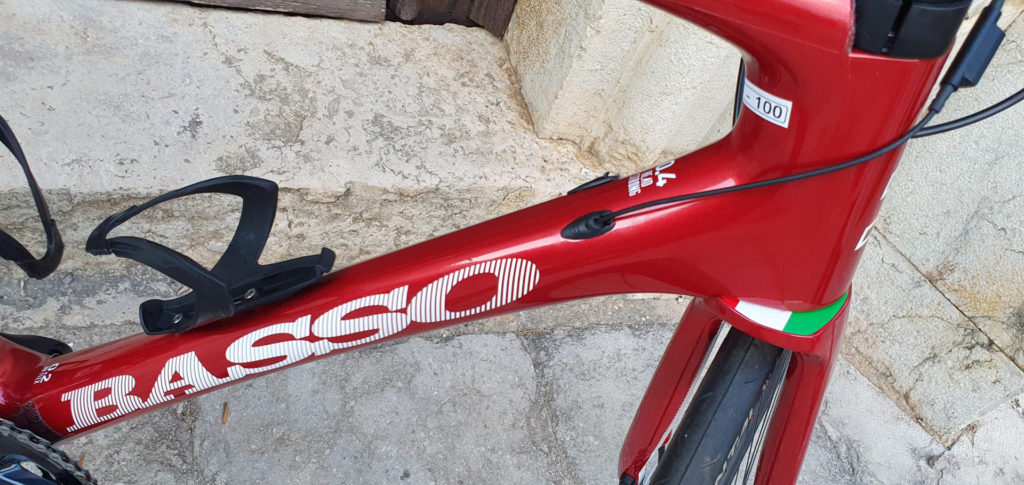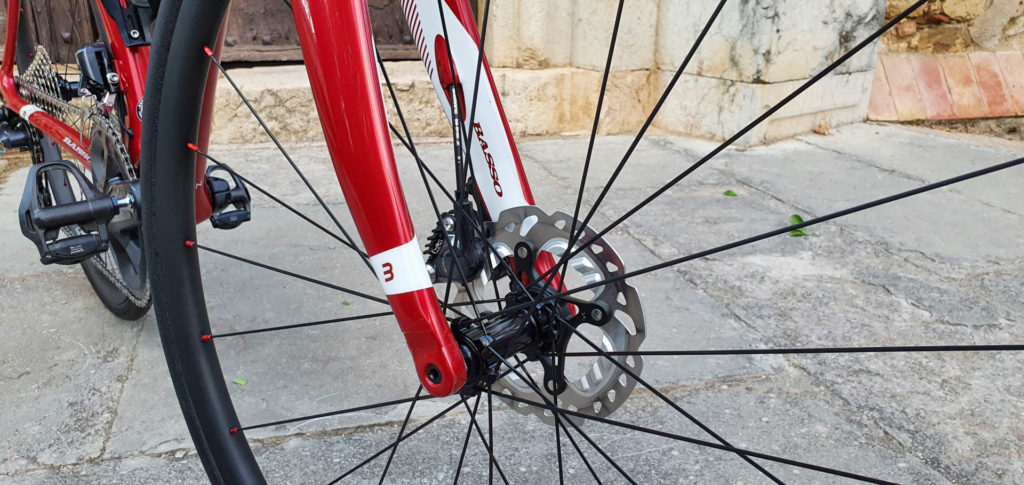Pyrenees Cycling Tour
Riding Days
6
Number of Nights
5
Total Distance
420km
Total Climbing
11,300 metres
Difficulty
4/5
At a Glance
'Circle of Death' is a rather dramatic name describing the ring of mountain passes centred around ‘Le Geant’, the Tourmalet.
Pyrenees Cycling Tour is based on one of our favourite routes through the Pyrenees, the riding includes famous climbs, like the Col du Tourmalet and Col d’Aubisque, as well as many lesser-known, but equally magnificent cols, such as the Port de Bales and Hourquette d'Ancizan, both used in the Tour de France regularly in recent years. These mountains have seen many great cycling champions relinquish their reign to more youthful hopefuls during many Tours de France since they were first introduced back in 1910.
The Pyrenees offer a completely different experience to the Alps. Where the Alpine climbs tend to be wider and more engineered carriageways up to remote ski resorts, the Pyrenean offerings are much more agricultural in comparison. The whole feel of the Pyrenees is different and refreshing. The towns and villages that you pass through are almost trapped in time and still feel cut off and remote from the rest of civilization, not so much focussed on mass tourism but on a subsistence of the local population. You'll receive a friendly welcome from the locals and be enchanted by this magical region which will leave you wanting to come back for more.
Tour Highlights
-
Asphalt
Book Tour
€1,750.00 – €2,895.00
Overview
Pyrenees Cycling Tour - About Pyrenees Culture & Cuisine
Pyrenees Cycling Tour will take you into a very unique mountain range, separating the Iberian peninsular from the rest of mainland Europe. The cultures and traditions are distinctly different from the rest of France. Although a language barrier separates the Spanish part and French parts of the Pyrenees the populations have been historically similar. The Basque population, which are more associated with the Spanish region, transcends the mountain range and you’ll find similar cultures and equally unpronounceable place names – to a native English speaker – on both sides of the border. The same is true in the southern Pyrenees area with Catalan being spoken on both sides of the modern day French Spanish border, but the cultural heritage reaches both sides of the border.
The landscape of the “Haute Pyrenees” is one of lush green valleys, backed by craggy snow-topped peaks. The mainstay of the mountains is still agriculture, and throughout the Summer you will see people working in the fields toiling away in a traditional way. The high mountains, narrow valleys which ride rapidly to the sky, separated the people from the rest of the France so much so that they speak a language called Occitan which is indistinguishable from French. The valley which leads to the Tourmalet is called Val de Luz referring to the light which is let into the valley between the high mountain peaks. The valley leads to the ‘Pays Toy’, a name that originates from the Gascon language and referring to small stature of the inhabitants of the mountainous area.
The cuisine of the Pyrenees, as you may expect is very hearty, designed to keep warm in winter and sustain a day of hard labour on the mountain terrain in the summer. This is also perfect for cyclists looking to fuel up after a day of climbing mountains. You can find a mixture of local produce characterised by thick soups, stews, roasts, and local game. You are likely to see an abundance of locally grazed lamb and also popular duck (Magret de canard) goats cheeses milks and hams all sourced locally and you’ll sure to see some of the produce as you travel through the region.
Pyrenees in the Tour de France
The Tour de France celebrated its 100th edition in 2013 with festivities in Paris and two ascents of Alpe d’Huez incorporated into the route. The first high mountains to be included in the Tour were not in the Alps but in the Pyrenees.
In 1910 Octave Lapize was famously quoted as saying ‘Vous étes des Assasins’ – ‘You are murderes’ as he passed over the summit of the Col d’Aubisque. The stage was a murderous 326km slog from Luchon to the coast at Bayonne tackling the Col de Peyresourde, Col d’Aspin, Col de Soulour, Col d’Aubisque and the highest pass in the Pyrenees the Col du Tourmalet. This was the very first time high mountains had been included in the Tour de France and the roads were not as we see them today, but dusty and rutted unsealed roads winding their way up these great Pyrenean mountains.
The Col du Tourmalet was celebrated in the 2010 edition of the Tour de France by traversing both sides on consecutive stages with the final ascent finishing on the top of the Giant of the Pyrenees, Andy Schleck was the victor over Alberto Contador during that stage.
The ‘Circle of death’ area of mountains have seen many great cycling champions relinquish their reign to more youthful hopefuls. In 1991 Greg Lemond cracked on the Tourmalet with a young Miguel Indurain benefiting and claiming the yellow jersey in his first of five tour victories. Five years later it was Miguel Indurain’s turn to crack as Bjarne Riis used his brute strength to continually surge up the Hautacam and signal an end to the dominant Spaniards grip on the Tour.
Climate
You will be climbing to over 2000 metres on the Pyrenees Cycling Tour, storms may happen, meaning that you could be riding in sweltering heat one minute and then experience downpours the next. As always, it’s a good idea to pack some light rain gear just in case. A gilet and arm warmers should suffice to keep you warm on the descents if the temperatures are on the cooler side.
Gearing
Although the gradients are not as steep as the Dolomites, a compact chainset (offering gearing of 34-50) with a 30 or 32 lowest gear on the cassette is recommended.
Details
What's Included
What's not Included
Itinerary
Your La Fuga guides will pick you up from either Pau or Toulouse Airport and take you to your hotel in Pau; this drive will be a short ride from Pau, or 1hr 45 from Toulouse.
At the hotel we will help you check in and our mechanic will build your bikes and make sure it is ready for the journey to follow. Depending on arrival time you may be able to get in an afternoon spin to open the legs up. Your tour manager will brief you about the journey ahead ahead of dinner. We’ll dine in the hotel with an excellent meal ahead of the first real day of riding.
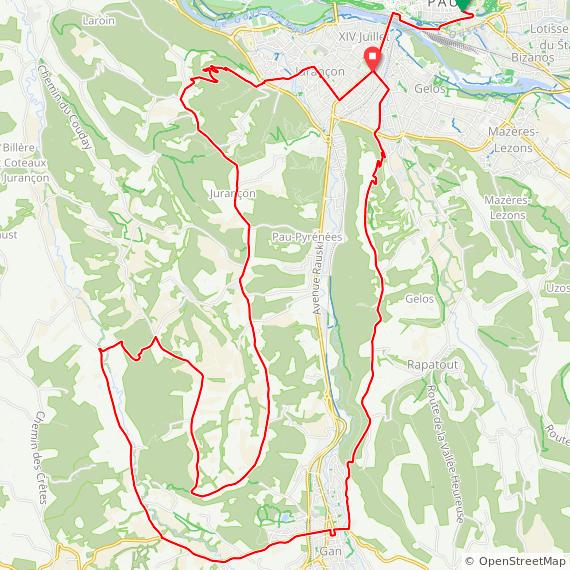

The first day of Pyrenees Cycling Tour starts with a gentle roll out of Pau and along some quiet roads to the first big challenge. The Col de Marie Blanque is one of the steepest climbs in the Pyrenees, a real challenge with the slopes getting steeper as you near the top. The last 4km rise a percent per kilometre just to really test the legs on day 1.
A great descent is a reward for all your efforts before rolling up the valley towards the mighty Col d’Aubisque. At 16km long the Aubisque is a stunning beautiful ascent and you’ll be able to enjoy the views across the jagged valley below. A short descent then sees us climb the last part of the Col de Soulour before a great descent to the town of Saint-Savin. Only a few kilometres remains up the valley to the hotel. You’ll dine in the hotel with an excellent meal cooked up by our host chef.
Shorter Route – There is an option to take a shorter route and miss out on the Col de Marie Blanque. This will reduce the distance by 30km and around 500 metres of climbing.
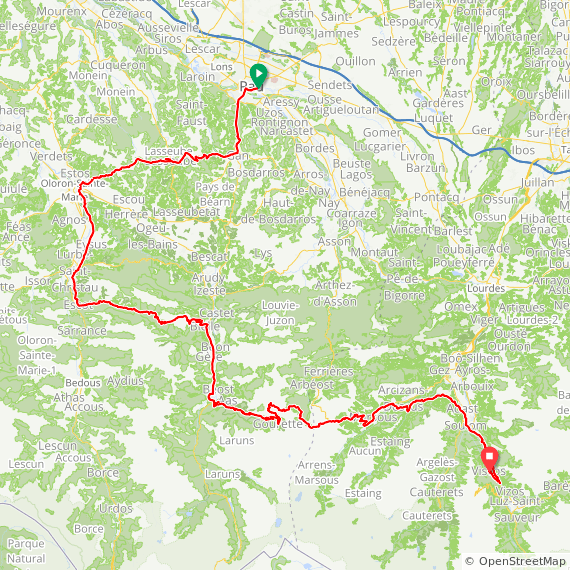

Today you will tackle the Giant of the Pyrenees; the Col du Tourmalet. The days riding starts with a gentle roll away from the hotel and up the valley to Luz Saint Sauveur. This marks the start of the Col du Tourmalet.
The Tourmalet is the king of the ‘circle of death’ with all other climbs circling around it. It’s known as the ‘Geant of the Pyrenees’ and has its own ‘Geant’ statue as a poignant reminder. The next 19km reach for the sky reaching the summit at 2115m above sea level.
There will be time to enjoy some lunch overlooking the surrounding mountains from the top of the Tourmalet. After a bite to eat there will be a spectacular descent through the ski resort of La Mongie and onto St Marie de Campin. The Col d’Aspin is the final climb that stands in your way, before arrival at Saint Lary Soulan. The Col d’Aspin is a beautiful climb that has some tough sections towards the top. The descent on the eastern side is a delight that arrives into the town of Arreau with a short journey along the valley to the quaint Pyrenean town of Saint Lary Soulan.
Longer Option. There is a longer option available which will involve the climb of Luz Ardiden ahead of the Tourmalet. Luz Ardiden has seen 8 Tour de France finishes. It climbs 14km from the valley floor remaining exposed all the way up enabling you to get a great view of the valley below.
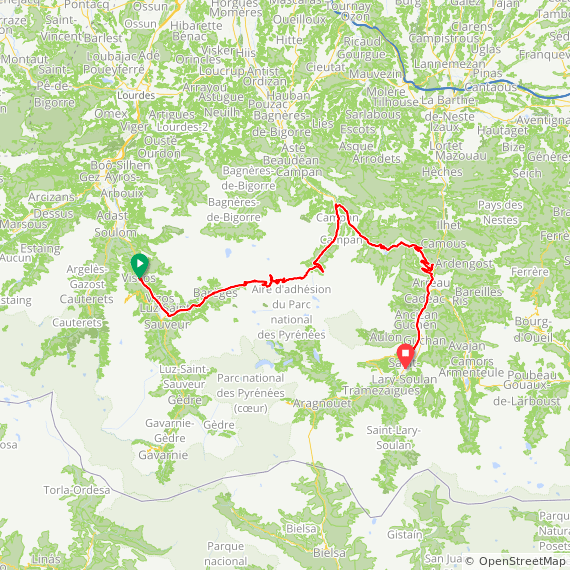

Day 4 will be a circular loop returning to the same hotel in Saint Lary Soulan for a second consecutive night. The day’s route sees three main climbs. The climb of the Col de Val Louron takes us some very quiet roads to Loudonville, which has seen the Tour de France visit a number of times in recent years with a favoured finish to the resort of Peyragudes.
The descent that follows is actually part of the Col de Peyresourde descent to Arreau. You’ll tackle that climb tomorrow. The next climb on the menu is the Col d’Aspin, the opposite side to yesterday. A very gentle and steady climb where you’ll be able to stop for lunch and fuel up for the final climb of the day. The final climb of the Horquette d’Ancizan is a very quiet climb that feels more like climbing in the north of England than in the Pyrenees. All that remains is the descent into St Lary Soulan and a refreshing drink.
You should have time in the afternoon to wander around the town and relax. Dinner will be in the town in the evening with a possible visit to an artisan Cider brewery, the only one in the Pyrenees.
Longer Route – If you want an additional challenge, the climb of Pla d’Adet can be tackled on return to Saint Lary. It has been used in the Tour de France several times, with George Hincapie taking a victory there in 2005.
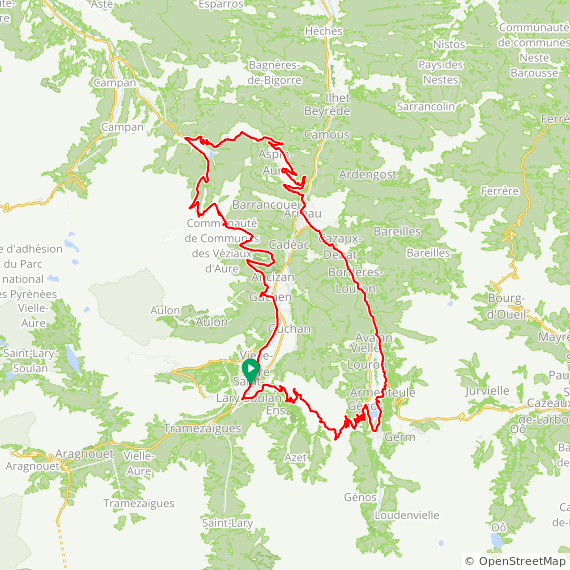

The last full day of riding involves some excellent climbs. After a downhill start to the town of Arreau, you’ll start the Col de Peyresourde. The Col de Peyresourde from the Arreau side is short at 9.5km long. The difficulty is found after 2km into the climb where the gradient doesn’t drop below 8% with many steeper sections. The descent however is a dream with wide smooth tarmac, this is where Chris Froome famously descended in a super tuck position to win the stage into Luchon in the 2016 Tour de France.
The next climb is the Port de Bales, the entire climb is a beautiful and quiet road that has only received tarmac relatively recently. It was resurfaced in 2006 with the intention of the Tour de France passing over it for the first time in 2007. Since then the Tour has been using it frequently with another four ascents. The climb is almost 20km long averaging 5.7% but has a varying gradient providing an extra challenge to tired legs.
You’ll stop for lunch to refuel at the summit of the Port de Bales and enjoy the tranquillity of the area. The descent takes you down to the valley floor through the forest with all that remains is a ride up the valley to Luchon where you’ll find your final hotel in this quaint and bustling mountain spa town.
Your final celebratory dinner will be taken in a local restaurant in the town where you can soak up the elation of an amazing few days riding the ‘circle of death’.
Longer Option – Should you want another challenge the climb of Super Bagneres can be climbed from Luchon. This is a dead-end climb that has seen many mountain top finishes of the Tour.
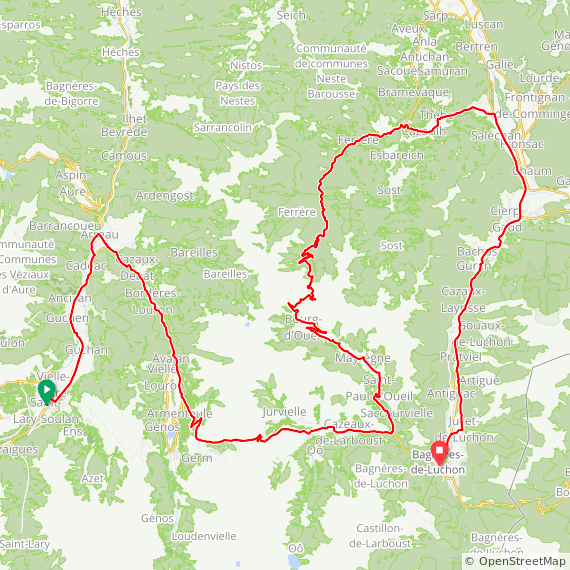

For those keen to do one last ride there is the opportunity to do a short circular loop into Spain. From Luchon you start climbing immediately up the Col du Portillon into Spain. The border between France and Spain is the summit of the Col. This Col has been used a staggering 19 times in the Tour de France. The descent takes you on a fast loop then turn up the valley back to Luchon.
Your bike will be packed away by your La Fuga mechanic and there will be chance for a a quick lunch before the journey back to Toulouse airport. The journey time is 1.5 hours.
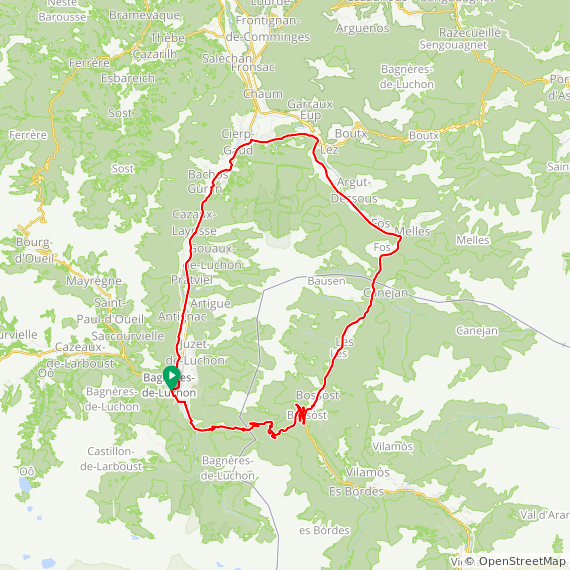

Accommodation
On the edge of Beaumont Park, a charming garden in the historic centre of Pau, the large, welcoming Hôtel Parc Beaumont stands in perfect harmony with its surroundings. Simple and elegant rooms and suites overlooking the park and the Pyrenees, a restaurant with a shaded terrace, and a radiant spa.
La Grange Aux Marmottes – Les Campanules is located in the Le-Pays-Toy valley, in the heart of the Pyrénées. A unique view of the valley and the village clinging to the mountain, the gentle tranquillity of the charming rooms and tasty local cousins in the hotels’ restaurant.
At the heart of the Pyrénées, St-Lary-Soulan is a unique and unspoilt village where you will receive the warm welcome typical of French mountain life. In a village at the heart of the Pyrenées, the Saint Lary Sensoria mountain hotel offers rooms with views of the peaks. Enjoy a relaxing time on the terrace in the centre of a garden giving onto the mountain. Or enjoy a session in the Thermal Spa and Fitness Centre. This is a hotel that has stayed true to its Pyrenean roots, cultivating a genuine charm and welcoming service.
Enjoy an unforgettable stay in a unique site where the heart of the Queen of the Pyrenees beats.
The Hotel Le Castel d’Alti offers a first glimpse of, behind its imposing gates, a U-shaped architecture from the 18th century, fully preserved and which surrounds a very large sun terrace.
The location of this former “mansion” built in the vibrant heart of the city, right in the middle of the famous Allées d’Etigny, is truly exceptional. At the back of the house, a second terrace opening onto a synthetic green allows users of the swimming pool to be able to relax in the generous sun of our central Pyrenees, which here have the largest concentration of peaks over 3000m in the chain.

